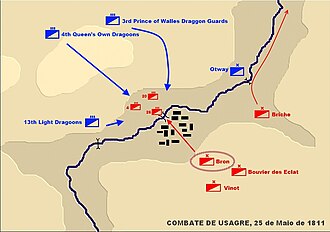This article includes a list of general references, but it lacks sufficient corresponding inline citations .(July 2011) |
| Battle of Usagre | |||||||
|---|---|---|---|---|---|---|---|
| Part of the Peninsular War | |||||||
 Combat of Usagre | |||||||
| |||||||
| Belligerents | |||||||
| | |||||||
| Commanders and leaders | |||||||
| | | ||||||
| Strength | |||||||
| 3,500 | 2,000 6 guns | ||||||
| Casualties and losses | |||||||
| 250 killed, wounded or captured [1] | 20 killed, wounded or captured | ||||||
 | |||||||
Castile 1811–13

137miles

In the Battle of Usagre on 25 May 1811, Anglo-Allied cavalry commanded by Major-General William Lumley routed a French cavalry force led by Major-General Marie Victor Latour-Maubourg at the village of Usagre, Spain, in the Peninsular War.
Contents
Beforehand, Lumley explored the area; the British hid their forces behind the ridge where they cannot be seen, while the French found themselves in a disadvantageous position when they were caught crossing the river and unable to exploit their numerical superiority. With the river just behind those Frenchmen who had already crossed it, the British took advantage of the opportunity by launching an assault; this means that in case of any tactical failure on the French side, withdrawal will be problematic, whilst the bridge at Usagre led straight into a defile, only access through which was a very narrow passage. [2] [3]